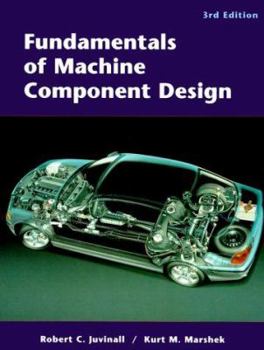Fundamentals of Machine Component Design
Select Format
Select Condition 
Book Overview
This indispensable reference goes beyond explaining the basics of mechanics, strength of materials, and materials properties by showing readers how to apply these fundamentals to specific machine... This description may be from another edition of this product.
Format:Hardcover
Language:English
ISBN:0471244481
ISBN13:9780471244486
Release Date:January 2000
Publisher:Wiley
Length:912 Pages
Weight:4.10 lbs.
Dimensions:1.5" x 8.4" x 10.3"
Customer Reviews
6 ratings
Fundamentals of Machine Component Design - 4Ed
Published by Mubeen , 8 years ago
Among all the books related to mechanical design that I bought for below 10$, this book and Spotts's Machine Design (6Ed.) are my absolute favorites. These two books are truly the best source of basic information on components' design, for undergraduate students.
Other books (which are good/better than these two mentioned above) e.g. Shigley, are insanely (10-20 times) expensive.
Makes you remember why you became an engineer in the first place
Published by Thriftbooks.com User , 17 years ago
This is a textbook for mechanical engineering design and also a reference book for practicing mechanical engineers. It is assumed that the reader has had courses in statics, dynamics, strength of materials, and material science. In other words, it is assumed you are the equivalent of at least a junior undergraduate in mechanical engineering. The first section of the book functions as a fast-paced review of the aforementioned prerequisites. Don't expect elementary straight numerical problems even in the introductory section. The author gets down to business immediately with example problems that involve actual mechanical devices. The example problem solutions are excellent with separate solution sections labeled "Known","Find", "Schematic and given data", "Assumptions", "Analysis", and "Comment". Each chapter has solutions to a few of the many exercises. Of particular interest in section one is chapter 8,"Fatigue", and chapter 9, "Surface Damage". Chapter 8 is important because it contains a simplified, condensed, and introductory version of fatigue design and fatigue crack growth, and is probably going to be new material for many readers. Chapter 9 deals with the various kinds of surface deterioration in machine components. This is important because more machine parts fail because of surface damage than from actual breakage. Part two of the book is concerned with the application of the fundamentals of mechanical engineering to specific machine components. In practice, problems involving the design, analysis, or application of machine members can seldom be solved by applying the fundamentals alone. Also, there is seldom just one right answer. This second section of the book gives the engineer exposure with these types of problems. Each chapter in this section deals with design issues in particular types of mechanical devices - springs, gears, bearings, clutches, brakes, etc. The final chapter of the section is a case study of the first commercially successful automotive automatic transmission, drawing on the knowledge of all of the individual devices studied in previous chapters of part two. The updates to this fourth edition versus the third edition are: * Chapter 1 has some new material including a hierarchy of design that sets design guidelines for minimizing risk as well as the documenting of a new product. * Section 3.14 "Engineering Material Selection Process" is new material. * Section 6.4 on "Fracture Mechanics - Applications" has been expanded. * There are two new sections in Chapter 8 entitled "Fatigue Crack Growth" and "General Approach for Fatigue Design". * There is more reference to various websites in this edition. * Both the example and homework problems have been revised. The third and previous edition of this book is only two years older than the current fourth edition, and actually contains about 100 pages more material than the fourth edition. Given the high cost of the fourth edition, and the fact that the third edition
Better then before
Published by Thriftbooks.com User , 18 years ago
This book does great with showing the easier way to do stress and strain analysis.
Excellent working reference with outstanding sample problems
Published by Thriftbooks.com User , 24 years ago
The first edition was a required college text, but I kept using it so much the cover wore out! The chapters are well laid out, and the sample problems really bring the main concepts into the real world. Every colleague to whom I have shown this book has been impressed.
handy reference- especially for new grads!
Published by Thriftbooks.com User , 25 years ago
This book was required for my first course in mechanical design and I've kept is as a desk reference at work. The book is well organized and practical. The techniques outlined in the later chapters apply good design techniques and provide usable information for machine component designers. I recommend this book to anyone requiring a mechanical reference.
fantastic engineering handbook-a must-have!
Published by Thriftbooks.com User , 27 years ago
This book explains in detail how a good design should be carried out, is easy to read and to use. It really makes engineers happy they chose to be what we are!




